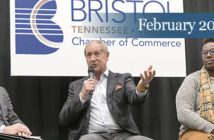Photo above: Patrick Wilson and David Jones discuss runway repair work. Photo by Scott Robertson
By Scott Robertson
The Tri-Cities Airport Authority continues to move ahead with its plan to create a business/industrial park for aeronautical companies. In its April 20 meeting, the authority unanimously voted to approve the expenditure of $82,000 to conduct a federally mandated environmental assessment of the land for Aerospace Park.
The authority also approved an agreement with Raymond James & Associates, which works with local governments including Washington County, on bond issues. The company helped that county’s government achieve a $19.5 million savings in what amounted to a $130 million refinancing of bonds in 2016.
General Assembly: TRI can bond park
Legislation to allow the Tri-Cities Airport Authority to issue bonds backed by the full faith and credit of the governments of Johnson City, Kingsport, Bristol, Sullivan County and Washington County passed both houses of the Tennessee General Assembly and was signed by Governor Bill Haslam in April. Each of those local governments must formally approve such a plan before it can move forward, but the state action was a necessary first step.
The airport authority seeks the ability to issue those bonds in order to fund creation of Aerospace Park. The airport is roughly $17 million away from being able to grade the land on the south side of the main runway and provide infrastructure for that project.
Aerospace Park is the brand the airport authority has given to its plan to turn 160 acres of fallow ground on the south side of the main runway into an industrial/business park for aerospace-based firms. The park would leverage not only the fact that the land represents the only Select Tennessee Certified development with direct airfield access, but also its proximity to Northeast State Community College for workforce training, a foreign-trade zone and on-site Customs.
$280,000 in runway repair needed
Some shuffling of funds will be necessary to fund repairs necessitated by a hollowing of karst beneath the runway.
“I’ve been here 30 years and it seems like every year there’s another sinkhole somewhere,” said Dan Mahoney, who chaired the April 13 Airfield Development Committee meeting in the absence of Ken Maness.
“It’s not a sinkhole yet,” clarified David Jones, director of operations. “But this is my fourth under the runway. We had six under Taxiway Romeo.”
“When we did the major rehab on the main runway in 2013, we installed additional edge drains along the runway to help alleviate these issues,” said Patrick Wilson, airport director, “but this problem could have been developing well before that.”
“Those other drains were about three feet deep along the edges,” Jones added. “We were putting grout in 50 feet deep in a couple of spots. That’s fairly deep for a pavement section that’s about two feet of pavement and subgrade down four or five feet maybe.”
“Well, we could blame it on the TVA,” Mahoney joked, referring to the five-to-seven year project the federal utility is managing to address a much larger problem with karst at nearby Boone Dam. “Everybody else around here is blaming things on them.”
“We share a little of their pain,” Wilson said, “but we’re not at that level.”




